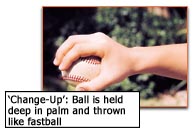Announcement
Junior Baseball Magazine On-Line We’ve talked about how to throw different kinds of fastballs and both the traditional and ‘safe’ curveball grips, too. The bottom line principle for young pitchers is to stick with the fastball until you’ve mastered it to the point where you can throw it for a strike, no matter the situation. But when the time comes to develop that second pitch, I suggest that it not be a curveball, but a ‘change of pace’, instead. For many pitchers your age, the curveball can be a pretty hard thing to throw for strikes. Even harder is developing the leverage needed to actually make the ball curve. The result often is a pitch that stays up in the strike zone. And curveballs that stay up are just another way of describing an extra-base hit waiting to happen. But a change-up is an easier pitch to master since the pitching motion for a change-up is (and really needs to be) exactly the same as you use when throwing the fastball. In fact, throwing it with the same motion is one of the principals behind the pitch. Change-ups are all about deception - making the batter think that a fastball is on the way. The difference is in the grip. Every-thing else remains the same. The change-up can be thrown with a variety of grips, the ‘circle change’ being the grip of choice. All you have to do is make an ‘OK’ sign with your thumb and first finger and place the ball snugly in the palm of your hand. Make sure the ball is held farther back in the hand than with your fastball grip. The pressure on the ball is applied with the middle knuckles. Again, this is different from the fastball, where the pressure is light and done by the fingertips. Someone should be able to take the ball from your hand without much effort when you’re using the fastball grip. Not so with the change-up. Some kids like using a ‘palm ball’ grip, which simply means you encase the ball, as much as you can, with all the fingers. Just find the grip that works best for you. Another important aspect of a good change-up, meaning one that stays down in the strike zone, is the follow-through. If your first attempts at throwing the change-up result in the ball bouncing somewhere near the top of the screen, just make sure your follow-through is more complete the next time. For a change-up to be successful, it doesn’t necessarily have to result in a swing and a miss for strike three. In fact, a lot of good coaches will say that you don’t want to throw a change-up for a strike with less than two strikes in the count. More often, a good change-up gets you one of those hoppers to shortstop for an easy out. Remember, getting the batter to think the fastball is coming is what a change-up is all about! If you can master the fastball, you’ll be able to get kids out in Little League. Master a second pitch and you’ll get them out in high school. Master a third pitch (curve, slider, etc.), and maybe some day you’ll be able to throw the ball for a living. Developing a good, consistent change-up is a terrific way to extend your baseball future. Just be patient, stick to the basics, and good things will happen. See The Picture Below For The Change-Up Grip !



Comments
There are no comments for this announcement.